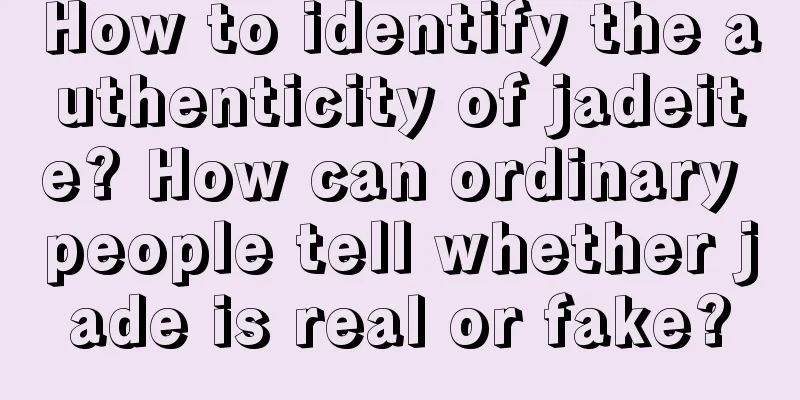How to identify the authenticity of jadeite? How can ordinary people tell whether jade is real or fake?

|
Since ancient times, Chinese people have been particularly fond of jade, and jadeite has become the king of jade in the jade market with its pure appearance and bright colors. Its prominent status and value in people's minds are naturally self-evident. Of course, where there is a market there is profit, so some unscrupulous merchants began to use some fake jade to sell as natural jade. How to identify the authenticity of jade has become a compulsory course for many jade lovers. So how do ordinary people distinguish the authenticity of jade? For many jade players, jade is not only rich in variety, but also has the complicated saying of "thirty-six waters, seventy-two kinds, and one hundred and eight colors". Sometimes they can't even distinguish the types of jade, let alone how to identify the authenticity of jade. So today we have summarized some practical methods used by old players to identify jade, and share them with you today. 1. Surface observation method The interior of jade is mostly granular in structure. The granular, flaky or fibrous porphyroclast cleavage inside can easily create a star-shaped flash, which is the "jade nature" of jade, also commonly known as "fly-wing flash" by experts. Therefore, when we observe jadeite, we can keep turning it and observe this phenomenon through the reflected light on its surface. Generally speaking, the rougher the texture of the jadeite, the easier it is to observe the "jade nature". At the same time, when we observe the "jade nature" of jade, we can generally observe the bumps on the surface of jade, which is the "orange peel effect". "Jade texture" and "orange peel effect" can effectively judge how to identify the authenticity of jade. 2. Look at the color Any jadeite with brighter colors needs to attract our attention. You can use a strong flashlight to illuminate the colored parts of the jade. If you see dense dye between the crystals or distributed in a spider-web pattern, you can determine that it is dyed jade. In addition, using a 10x magnifying glass to observe jade is also one of the methods to identify the authenticity of jade. Under a 10x magnifying glass, the color veins of A-grade jadeite are very natural and complete, with no color vein breaks; while the color roots and color veins of B-grade jadeite will appear unnaturally broken. fcgc66 fcpf18 |
Recommend
Jade, the one and only me, flawed but beautiful!
I am a piece of jade, formed by unique geological...
Do you know how the artistic conception presented in jade is formed?
Floating blue flower jadeite occupies a large sha...
Jade carvings are in great demand, and the main considerations when purchasing are design, workmanship, and beautiful colors and carvings.
Compared with bracelets and egg-shaped jades that...
When choosing jadeite, it is better to buy the right one than the expensive one!
There is an old saying in the jade industry: Jade...
How to identify C-grade jadeite whose color cannot be changed but quality?
If you want to identify C-grade jadeite, you must...
The carving process of jade
As the ancients said, jade cannot be made into a ...
What is jade waxing and wax dipping?
Waxing and wax dipping are two completely differe...
What kind of jade is violet jade?
As we all know, jade actually has more than one c...
Knowledge丨Is using jade to ward off disasters a superstition or a science?
The ancients believed that jade possesses the vir...
It is actually very simple to tell whether jade is A-grade. Even an ordinary person can tell it with this trick.
When you go to jewelry distribution centers and t...
The core of the spring-colored jadeite bracelet is carved with a dragonfly brand full of vitality, it is so beautiful!
Today I would like to share with you The process ...
Jade bracelet heart, a blockbuster design theme
Today I want to share with you a three-color jade...
5 Very Unreliable Jade Identification Methods
Jade is not only a wearable jewellery but also a ...
The key to buying jadeite, a comprehensive explanation of jadeite buying skills, and being a smart jade buyer
People who love jade have existed since ancient t...
Because of the right choice of subject matter, this jadeite stone instantly increased 10 times after being carved
As we all know, for a piece of jadeite raw stone ...









